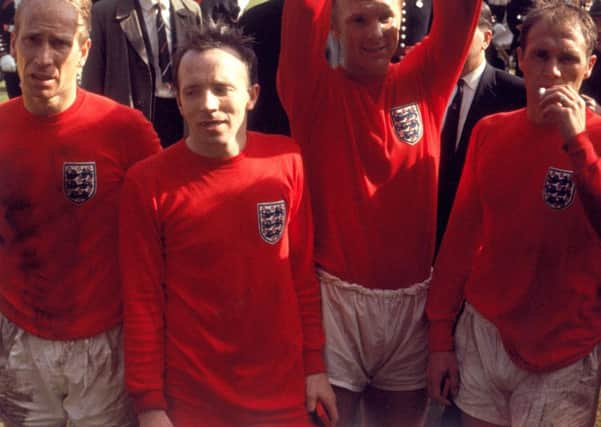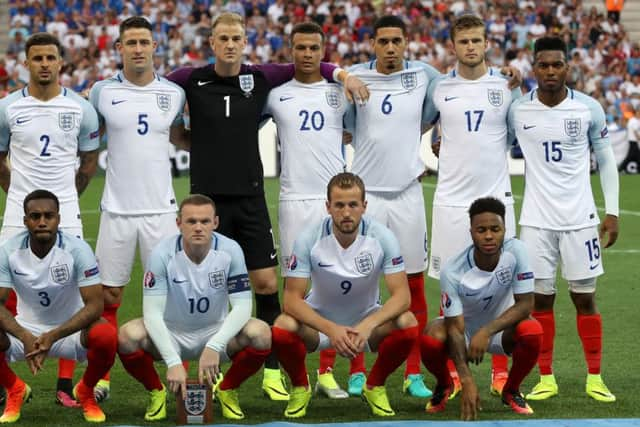The 1966 World Cup and the changing face of football


“They think it’s all over... It is now.”
These famous words, uttered by the BBC’s Kenneth Wolstenholme as Geoff Hurst rocketed in the fourth and final goal in the dying seconds of the World Cup final at Wembley, have become the stuff of legend. Over the past 50 years they have seeped into our national consciousness and are as instantly familiar as Winston Churchill’s wartime speeches or “the lady’s not for turning” stridency of Margaret Thatcher.
But rather than marking the end of a great sporting chapter in the annals of our national game, the 1966 World Cup, it can be argued, turned the page on a new footballing era – one populated by a growing phalanx of celebrities that would lead, eventually, to the Premier League gravy train we know today.


Advertisement
Hide AdAdvertisement
Hide AdFifty years ago, however, there was still an innocence about football in England. Back then it was a working- class sport where players and fans were cut from the same cloth, before the 1970s ushered in hooliganism and million-pound transfers.
One of the biggest disparities between then and now is footballers’ wages. Today’s England team pick up more than £1m a week from playing club football, which is topped up by international appearances, not to mention the plethora of sponsorship deals most of them enjoy. They have their PR and agents’ fees to pay, of course, but that’s just one slice of what is a very big cake.
It’s the kind of monopoly money that England’s World Cup heroes could only dream about. Following their victory over West Germany the players received a £22,000 bonus which they unanimously agreed would be shared equally between each of the 22 members of the squad.
This may seem a bit miserly given their achievement but it’s worth pointing out that the top players weren’t badly paid, relatively speaking. It was Jimmy Hill who, as the Professional Football Association (PFA) chairman, finally won the battle to have the wage cap abolished, paving the way for Johnny Haynes to become the first £100-a-week player in 1961.


Advertisement
Hide AdAdvertisement
Hide AdFive years later and this was the average footballer’s wage in England – putting them on a par with doctors. It was well above the national average at the time (£20 a week) and more than seven times the average wage of a farm labourer who got paid a paltry thirteen quid. Even so, George Cohen, England’s unsung right-back in the World Cup final, was earning just £80 a week when a knee injury ended his career three years later.
If footballers’ wages have gone through the roof then so, too, have transfer fees. England star Raheem Sterling joined Manchester City last summer for a reported £49m, making him the second most expensive British player of all time.
It makes you wonder how much the likes of Bobby Moore, Bobby Charlton and Jimmy Greaves would be worth in today’s grossly inflated market. You would have to pay north of that just for Charlton’s right foot.
Perhaps one of the most fundamental differences today is between the players themselves. Fifty years ago footballers were overwhelmingly working class and much of the England team’s character was defined by the years of hard graft many of the players had endured to get where they were.
Advertisement
Hide AdAdvertisement
Hide AdSeveral members of the squad, including Jimmy Armfield, Ray Wilson and Jack Charlton, had done National Service, while Sheffield-born Gordon Banks – still revered as one of the greatest goalkeepers of all time – was bagging coal at the age of 15 after leaving school.
There was little in the way of glamour. When Norman Hunter joined Leeds United as a teenager back in the early 60s he was tasked with reseeding the pitch and painting the dressing rooms at Elland Road and then, once the groundsman had finished with him, he could go and play football.
Star players weren’t feted and fawned over in the way they are in today’s media-saturated world. Most lived in terrace houses or semi-detached homes and those who had their own cars couldn’t afford anything flash.
Even when the World Cup was on England’s players could walk down the street without being mobbed by fans. Sir Geoff Hurst has said that on the day after England beat West Germany he was out cutting the grass and cleaning his car.
Advertisement
Hide AdAdvertisement
Hide AdContrast this with today’s top footballers who can afford to live in mansions and penthouse suites and who probably wouldn’t be seen dead mowing their own lawn.
A gulf has developed between players and fans and where they once mingled together in pubs or sat next to one another on the bus, they now lead entirely separate lives.
The success of Sir Alf Ramsey’s team revolved around teamwork, loyalty and discipline. There was a strong sense of pride about playing for your country which some people feel has waned in recent times.
Speaking on the excellent BBC documentary World Cup 1966: Alfie’s Boys, former West Ham and Tottenham manager Harry Redknapp said: “In those days getting picked for England was the most important thing in their lives.”
Advertisement
Hide AdAdvertisement
Hide AdHowever, football in this country has changed beyond all recognition since then. The advent of the Premier League in 1992 was a game-changing moment that has precipitated an unprecedented flood of TV money – in the latest deal Sky and BT Sport paid an eye-watering £5.136bn for live TV rights for the next three seasons.
But while we take football on TV for granted, or bemoan the fact that we have too much of it, fifty years ago it was very much a novelty. The 1966 World Cup wasn’t the first tournament to be televised, but with its blanket coverage and a global audience that ran into the hundreds of millions it certainly took it to another level.
It’s easy to wallow in misty-eyed nostalgia whenever we talk about the World Cup of ‘66 and one of the reasons we do is because we haven’t come close to winning the trophy since.
It is rightly remembered for the brilliance of Eusebio and Bobby Charlton’s match-winning goals, but it ought not to be forgotten that Brazilian superstar Pelé was effectively kicked out of the tournament after succumbing to injury brought about by tackles that at times bordered on assault.
Advertisement
Hide AdAdvertisement
Hide AdThis is something that stars of the modern game such as Lionel Messi, Ronaldo and Gareth Bale thankfully don’t have to face. And football is all the better for it.
It’s perhaps ironic that the genesis for the modern game as we know it today – with its superstars, TV pundits and high-tech gimmickry – began 50 years ago when a group of working- class lads and their quietly spoken, yet brilliantly inspirational, manager became heroes on a sunny day in July.
But then, as Jimmy Greaves once said, football is a funny old game.